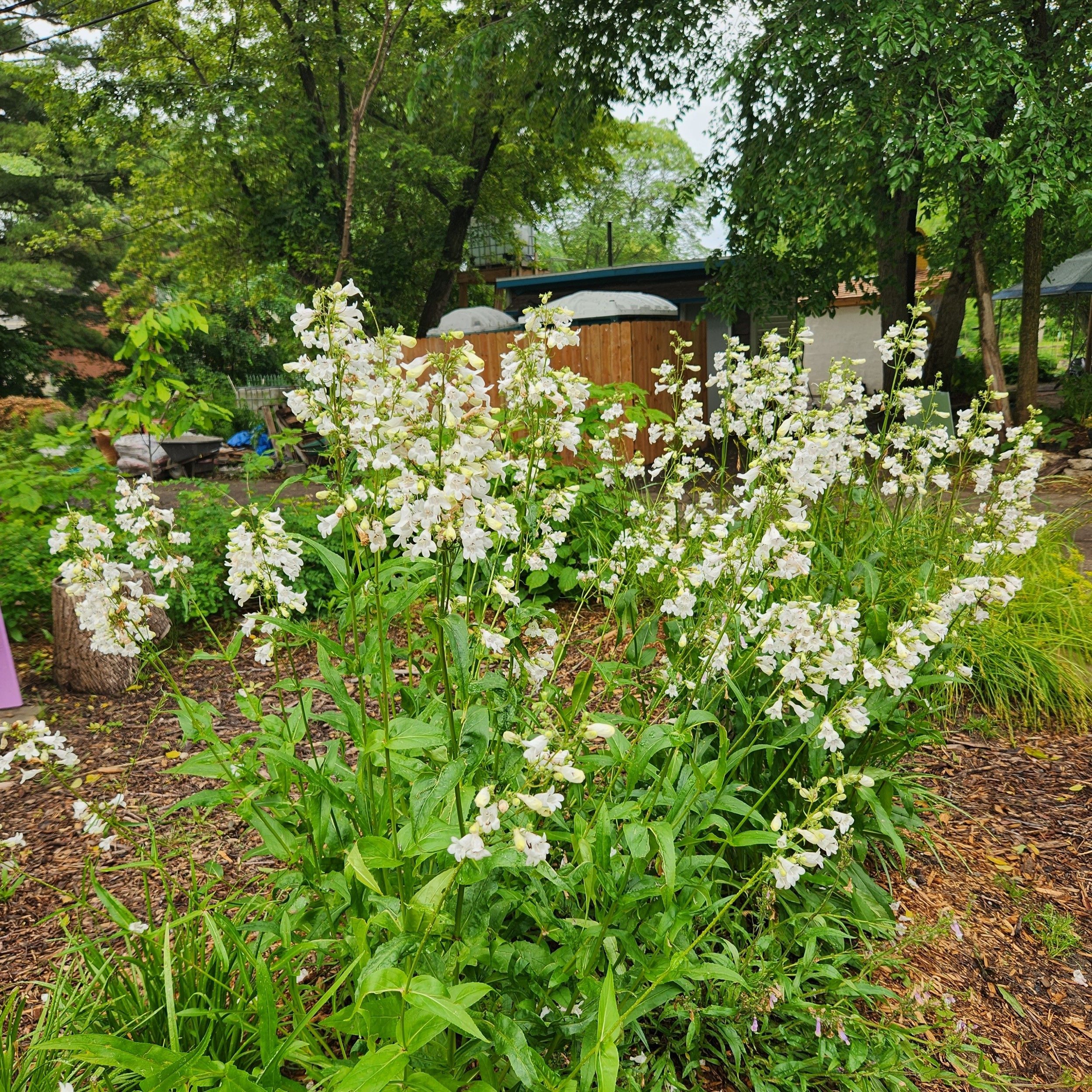Penstemon digitalis, Foxglove Beard Tongue, Quart pot
Penstemon digitalis, Foxglove Beard tongue4” pot
FS-PS, Zone 3, blooms June - July, 4’ x 2’, deer resistant, medium to dry, sand to some clay.
Penstemon digitalis is a clump-forming, Michigan-native perennial which typically grows 3-5' tall. It occurs in prairies, fields, wood margins, open woods and along railroad tracks. It can adapt to many different soil and moisture conditions. Foxglove Beard Tongue blooms during its first year. We have two beautiful stands of this plant, one in partial shade and the other in full sun. A grouping of three individual plants provides an attractive, solid 4-5’ spread. The flowers produce nectar at a time in late spring when earlier nectar sources are drying up, but summer sources have yet to start.
They spread slowly through self-seeding and the parent plant produces small rosettes that can be relocated. They are one of the first long-lasting perennial blooms of the season and even though I cut some every few days for bouquets, they’re still quite a show. Bumble bees visit the tubular flowers one by one, from the bottom up, moving pollen as they go, guided by the light violet lines inside the tubular flowers. The common name ‘beardtongue’ comes from the hairs that line the tubular flower structure. They force the bee to dive deeper.
Attracts native bumble bees, honey bees, butterflies, hummingbirds and some specialist bees like the Digger bees. Butterfly host plant for the Common Buckeye and also moth species.
Penstemon digitalis, Foxglove Beard tongue4” pot
FS-PS, Zone 3, blooms June - July, 4’ x 2’, deer resistant, medium to dry, sand to some clay.
Penstemon digitalis is a clump-forming, Michigan-native perennial which typically grows 3-5' tall. It occurs in prairies, fields, wood margins, open woods and along railroad tracks. It can adapt to many different soil and moisture conditions. Foxglove Beard Tongue blooms during its first year. We have two beautiful stands of this plant, one in partial shade and the other in full sun. A grouping of three individual plants provides an attractive, solid 4-5’ spread. The flowers produce nectar at a time in late spring when earlier nectar sources are drying up, but summer sources have yet to start.
They spread slowly through self-seeding and the parent plant produces small rosettes that can be relocated. They are one of the first long-lasting perennial blooms of the season and even though I cut some every few days for bouquets, they’re still quite a show. Bumble bees visit the tubular flowers one by one, from the bottom up, moving pollen as they go, guided by the light violet lines inside the tubular flowers. The common name ‘beardtongue’ comes from the hairs that line the tubular flower structure. They force the bee to dive deeper.
Attracts native bumble bees, honey bees, butterflies, hummingbirds and some specialist bees like the Digger bees. Butterfly host plant for the Common Buckeye and also moth species.
Penstemon digitalis, Foxglove Beard tongue4” pot
FS-PS, Zone 3, blooms June - July, 4’ x 2’, deer resistant, medium to dry, sand to some clay.
Penstemon digitalis is a clump-forming, Michigan-native perennial which typically grows 3-5' tall. It occurs in prairies, fields, wood margins, open woods and along railroad tracks. It can adapt to many different soil and moisture conditions. Foxglove Beard Tongue blooms during its first year. We have two beautiful stands of this plant, one in partial shade and the other in full sun. A grouping of three individual plants provides an attractive, solid 4-5’ spread. The flowers produce nectar at a time in late spring when earlier nectar sources are drying up, but summer sources have yet to start.
They spread slowly through self-seeding and the parent plant produces small rosettes that can be relocated. They are one of the first long-lasting perennial blooms of the season and even though I cut some every few days for bouquets, they’re still quite a show. Bumble bees visit the tubular flowers one by one, from the bottom up, moving pollen as they go, guided by the light violet lines inside the tubular flowers. The common name ‘beardtongue’ comes from the hairs that line the tubular flower structure. They force the bee to dive deeper.
Attracts native bumble bees, honey bees, butterflies, hummingbirds and some specialist bees like the Digger bees. Butterfly host plant for the Common Buckeye and also moth species.




